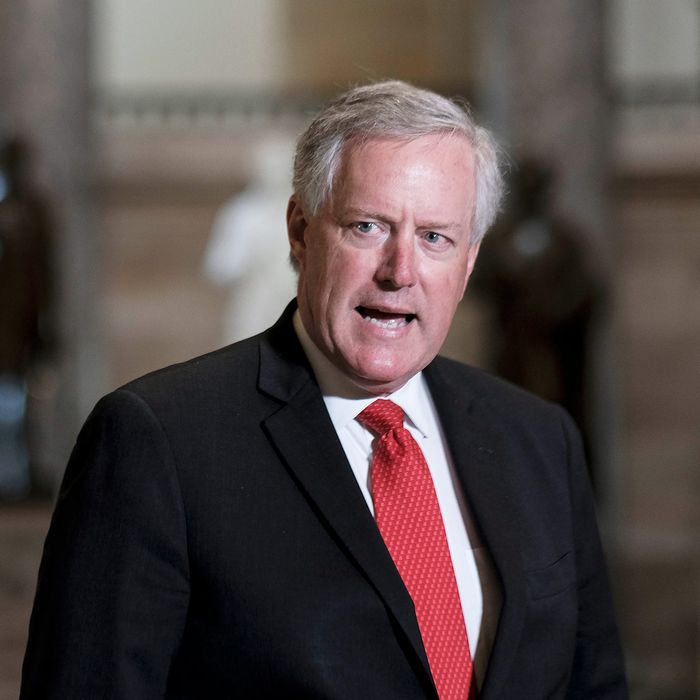Republicans Abandon Stimulus Checks As Talks Slip to End of Fiscal Year
Republicans Abandon Stimulus Checks As Talks Slip Toward End of Fiscal Year
By
Ed Kilgore
Meadows says a deal will be cut mañana. Photo: Gabriella Demczuk/Getty Images
If you’ve been trying to follow the progress, or lack thereof, toward a successor to the CARES Act that would provide pandemic relief and stimulus, you’ve likely been frustrated. With negotiations stalled and Congress in recess, there hasn’t been much to report — and now, it looks like the process is about to get delayed even further.
Allow me to offer a brief recap of the winding journey Congress has taken on additional COVID-19 relief. On May 15, the House
passed the HEROES Act, a bicameral Democratic proposal for $3.4 trillion in new coronavirus-related assistance. On July 27, Senate Republicans unveiled, but did not take further action on, the
HEALS Act, their own $1 trillion bill, with support from the White House, and entered into negotiations with Nancy Pelosi and Chuck Schumer.
Many key CARES Act provisions
expired on July 31, including supplemental unemployment insurance and an eviction moratorium for federally assisted rental housing. On August 8, President Trump
signed four “orders” allegedly addressing the needs associated with expiring CARES Act provisions, but they would provide
marginal relief at best, amid great legal and administrative chaos. Around that same time, Pelosi and Schumer
offered to get negotiations back on track by “splitting the difference” with Republicans over the total cost (with each side moving a trillion dollars toward each other), but the White House said no thanks.
On August 19 it was
reported that Senate Republicans were developing a new “skinny” proposal that moved even further away from the Democratic position and abandoned the
second round of stimulus checks that had been the glue for any agreement. And now CNBC is
reporting that Republicans are preparing a revised “skinny” proposal that drops liability shield provisions and raises supplemental unemployment insurance payments a bit from prior GOP plans, but still comes in at half the HEALS Act price tag and does not include a second stimulus check. As part of an effort to pretend Republicans are eager to jumpstart a return to negotiations, White House chief of staff Mark Meadows
let it be known he planned to call Pelosi this very day. But Pelosi instantly
said she wasn’t interested in negotiating unless Meadows was ready to meet Democrats halfway on the overall price tag.
The insincerity of this alleged Republican gesturewas illustrated earlier this week when Politico
reported that any deal in September ain’t happening, per Meadows himself:
White House Chief of Staff Mark Meadows said Wednesday he is not optimistic about reaching a new coronavirus relief deal before the end of September, predicting House Speaker Nancy Pelosi will use the government funding cliff at the end of next month as leverage to strike a deal on pandemic aid …
The White House chief of staff said lawmakers from both parties have privately expressed to him a desire to make progress on coronavirus relief. The holdup, Meadows said he suspects, is that Pelosi is holding back her party’s rank and file in order to secure more Democratic priorities in any legislation.
Yeah, right. The old “individual members of the opposition, whom I cannot name, want to cave to us but mean old Nancy Pelosi won’t let them” song and dance.
Remember, it was Democrats who made the last compromise effort on a stimulus deal. So it’s more likely that in looking to a fiscal-year-ending stopgap-funding bill as a vehicle, Pelosi is looking for leverage to force any kind of stimulus deal. And in doing so, she probably realizes that avoiding a government shutdown may give Senate Republican fiscal hawks just enough incentive to vote “aye” on stimulus (
at least 20 of them reportedly oppose doing anything at all).
But why is a government shutdown on the table? You may recall that at about this time last year Trump signed a
two-year budget deal that allegedly punted funding fights until after the 2020 elections. But all it actually did was to extend the public-debt limit — often a trigger for shutdown threats — until after November, while resetting spending caps to accommodate both parties’ overall priorities (defense spending for Republicans, domestic spending for Democrats). But appropriations bills still have to be enacted and signed before the end of the fiscal year (on September 30), and at this point the Senate has not passed a single one of them out of the Appropriations Committee (the House passed spending bills in
two big packages).
Why is that? Well, Senate Republicans
want to protect vulnerable Appropriations Committee members Susan Collins and Steve Daines from any controversial votes on amendments Democrats might devise until they are safely past Election Day. And so, the table is set for a big fat omnibus stopgap “continuing resolution” keeping the federal government functioning beyond September 30. And that’s obviously the right vehicle for anyone interested in forcing a stimulus deal.
The bad news, of course, is that renters facing evictions, unemployed people whose benefits have been cut, small businesses with no more loan access, struggling state and local governments, struggling schools, and
really struggling election officials are going to have to wait another month or so for even a good chance of relief. And the unfairly denied will also include those many millions of Americans who are wondering where that
second stimulus check they’ve been counting on will finally appear.
It’s not just a matter of timing, either: Any time you are dealing with a possible government shutdown, hostage-takers appear from every direction, insisting that their pet legislative or spending priorities really must be accommodated. And the hostage-takers this time around could most definitely include an endangered president of the United States. So those hoping for relief or stimulus should hang onto their butts; it could be a wild ride.







 coward
coward
coward
